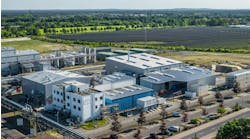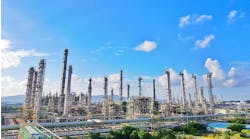"Have you got a quick estimate of how big the motor should be for the air compressor?" Pinaki asked, as he was rushing to complete a proposal. I handed him a table I'd used — and checked out — from a trusty source: Hank Van Ormer, a technical expert on air compressors and Chemical Processing author (www.ChemicalProcessing.com/articles/2006/107.html and (www.ChemicalProcessing.com/articles/2005/12.html). The brake horsepower (hp) necessary for a compressor producing 125 psig air at 100° F is the flow rate in cubic feet per minute, Q, times 0.26. So, for example, a 1,000-cfm compressor requires1,000 × 0.26 = 260 hp. This perfectly illustrates the value of Rules of Thumb (ROT).
Here's another useful ROT from a well-known handbook: the quantity of liquid escaping from a small leak in gallons per minute, Q, roughly equals 18d2(P/S)0.5, where d is hole equivalent diameter in inches, P is initial pressure in psig and S is liquid specific gravity. This simplification probably overestimates the flow but still can be handy for gauging loss through a leaky tube in a heat exchanger.
The same handbook provides a ROT for gas leakage: Q = d2P. Q is in million standard cubic feet per hour at 14.9 psia and 60° F, d is the hole equivalent diameter in inches and P is initial pressure in psia.
While the liquid equation is a good approximation, I can easily shoot holes in the gas one. What about condensing, i.e., wet, gases? What about critical flow? When the ratio of plate thickness to bore diameter is less than six, Cunningham showed that flow isn't choked — that ratio probably assures critical flow for pipe walls and vessels but not tubes. Here're a few more questions: What about gas compression because of the Joule effect (cooling)? What of the flow coefficients? For a field calculation with a dry gas this ROT is a rough guess at best.
Most ROT demand a fair amount of skepticism.
However, here're a few I've collected and successfully used over the years:
1. For gravity flow with water, allow a half-inch drop for a 10-ft. run; use a 10% drop for viscous liquids.
2. For a conservative estimate of motor size, determine minimum motor efficiency via submin = 83.59373 + 2.28423 Ln(hp).
3. To estimate minimum vessel wall thickness, use tmin = 1.25(Pd/4a) + C, where tmin is in inches, P is design pressure in psig, d is vessel outside diameter in inches, suba is allowable stress in psi (plug in 10,000 psi for an unknown steel below 500° F, 20,000 psi for carbon steel below 400° F and 17,000 psi for Type 304 stainless steel below 300° F) and C is the corrosion allowance in inches (use 1/8 normally or ¼ for severe services). Check pipe schedule by this rough approximation: Schedule ~ 1,000P/sub>a.
4. For oxide protection, use the 1923 Pillman-Beckwith correlation: β= Mρm/nAρox, where M is metal oxide molecular weight, n is the number of atoms in the oxide, A is atomic weight of the metal, and >m and >ox are densities of metal and oxide, respectively. A β≤ 1 indicates the metal will corrode away; a β > 1 indicates the oxide layer formed by corrosion protects the metal unless cracked by thermal stress. The Pillman-Beckwith correlation really works. Try it for aluminum.
In addition, there's an interesting set of recommended minimum and maximum pipeline velocities based on experience: cooling water, 8–15 ft. per second (fps); general liquid process lines, 4–10 fps; non-slurry suction lines, 2–5 fps; abrasive slurries or plastic lines, 1–8 fps; dirty liquids or soft slurries, 6–12 fps; and clean process gases, 30–60 fps. Pressure drop figures in some gas or vapor guidelines but these numbers should be approximately correct.
Here's a useful ROT for mixtures: If the stream fluids have similar heat capacities and mixture heat capacity doesn't change much, estimate the final mixture temperature by taking the weight or mole average of the streams.
Finally, keep in mind some ROT for packed towers: Keep spacing between liquid distributors at seven and ten tower diameters. The turndown ratio for a tower using a spray nozzle is only 2:1. Fill towers with packing 1/15 to 1/8 the size of the tower diameter. The Height Equivalent to Theoretical Stage (HETS) is about 1.3 ft for 1-in. Pall rings and 2.5 ft. for 2-in. Pall rings. Most modern packing performs better than these values but they're good estimates.
As long as you don't blindly accept the results, ROT can have value for budget estimates and field calculations.
Dirk Willard is a Chemical Processing Contributing Editor. You can e-mail him at [email protected].


